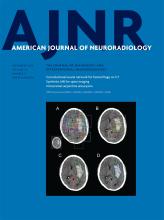Research ArticlePatient Safety
Gadolinium Deposition in Deep Brain Structures: Relationship with Dose and Ionization of Linear Gadolinium-Based Contrast Agents
H. Kang, M. Hii, M. Le, R. Tam, A. Riddehough, A. Traboulsee, S. Kolind, M.S. Freedman and D.K.B. Li
American Journal of Neuroradiology September 2018, 39 (9) 1597-1603; DOI: https://doi.org/10.3174/ajnr.A5751
H. Kang
aFrom the Department of Radiology (H.K., M.L., R.T., S.K., D.K.B.L.)
M. Hii
bUniversity of British Columbia MS/MRI Research Group (M.H., R.T., A.R., A.T., S.K., D.K.B.L.)
M. Le
aFrom the Department of Radiology (H.K., M.L., R.T., S.K., D.K.B.L.)
R. Tam
aFrom the Department of Radiology (H.K., M.L., R.T., S.K., D.K.B.L.)
bUniversity of British Columbia MS/MRI Research Group (M.H., R.T., A.R., A.T., S.K., D.K.B.L.)
A. Riddehough
bUniversity of British Columbia MS/MRI Research Group (M.H., R.T., A.R., A.T., S.K., D.K.B.L.)
A. Traboulsee
bUniversity of British Columbia MS/MRI Research Group (M.H., R.T., A.R., A.T., S.K., D.K.B.L.)
cDepartment of Medicine and Division of Neurology (A.T., S.K., D.K.B.L.)
S. Kolind
aFrom the Department of Radiology (H.K., M.L., R.T., S.K., D.K.B.L.)
bUniversity of British Columbia MS/MRI Research Group (M.H., R.T., A.R., A.T., S.K., D.K.B.L.)
cDepartment of Medicine and Division of Neurology (A.T., S.K., D.K.B.L.)
dDepartment of Physics and Astronomy (S.K.), University of British Columbia, Vancouver, British Columbia, Canada
M.S. Freedman
eDepartment of Medicine and Division of Neurology (M.S.F.), University of Ottawa and the Ottawa Hospital Research Institute, Ottawa, Canada.
D.K.B. Li
aFrom the Department of Radiology (H.K., M.L., R.T., S.K., D.K.B.L.)
bUniversity of British Columbia MS/MRI Research Group (M.H., R.T., A.R., A.T., S.K., D.K.B.L.)
cDepartment of Medicine and Division of Neurology (A.T., S.K., D.K.B.L.)

References
- 1.↵
- 2.↵
- Frenzel T,
- Lengsfeld P,
- Schirmer H, et al
- 3.↵
- 4.↵
- Kanda T,
- Ishii K,
- Kawaguchi H, et al
- 5.↵
- Murata N,
- Gonzalez-Cuyar LF,
- Murata K, et al
- 6.↵
- 7.↵
- 8.↵
- Quattrocchi CC,
- Mallio CA,
- Errante Y, et al
- 9.↵
- Errante Y,
- Cirimele V,
- Mallio CA, et al
- 10.↵
- 11.↵
- 12.↵
- 13.↵
- Radbruch A,
- Weberling LD,
- Kieslich PJ, et al
- 14.↵
- 15.↵
- 16.↵
- Adin ME,
- Kleinberg L,
- Vaidya D, et al
- 17.↵
- 18.↵
- 19.↵
- Ramalho J,
- Semelka RC,
- Ramalho M, et al
- 20.↵
- 21.↵
- 22.↵
- 23.↵
- 24.↵
- Frenzel T,
- Apte C,
- Jost G, et al
- 25.↵
In this issue
American Journal of Neuroradiology
Vol. 39, Issue 9
1 Sep 2018
Advertisement
H. Kang, M. Hii, M. Le, R. Tam, A. Riddehough, A. Traboulsee, S. Kolind, M.S. Freedman, D.K.B. Li
Gadolinium Deposition in Deep Brain Structures: Relationship with Dose and Ionization of Linear Gadolinium-Based Contrast Agents
American Journal of Neuroradiology Sep 2018, 39 (9) 1597-1603; DOI: 10.3174/ajnr.A5751
0 Responses
Gadolinium Deposition in Deep Brain Structures: Relationship with Dose and Ionization of Linear Gadolinium-Based Contrast Agents
H. Kang, M. Hii, M. Le, R. Tam, A. Riddehough, A. Traboulsee, S. Kolind, M.S. Freedman, D.K.B. Li
American Journal of Neuroradiology Sep 2018, 39 (9) 1597-1603; DOI: 10.3174/ajnr.A5751
Jump to section
Related Articles
Cited By...
This article has not yet been cited by articles in journals that are participating in Crossref Cited-by Linking.
More in this TOC Section
Patient Safety
Similar Articles
Advertisement











